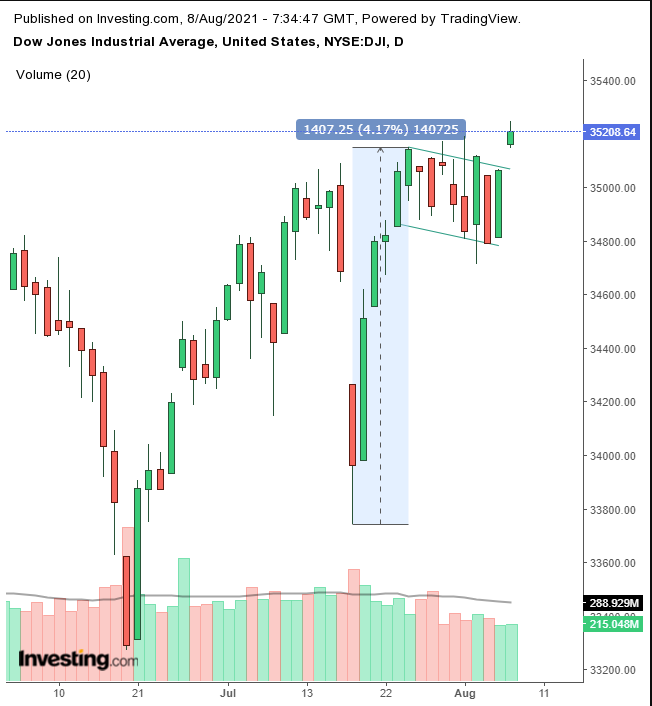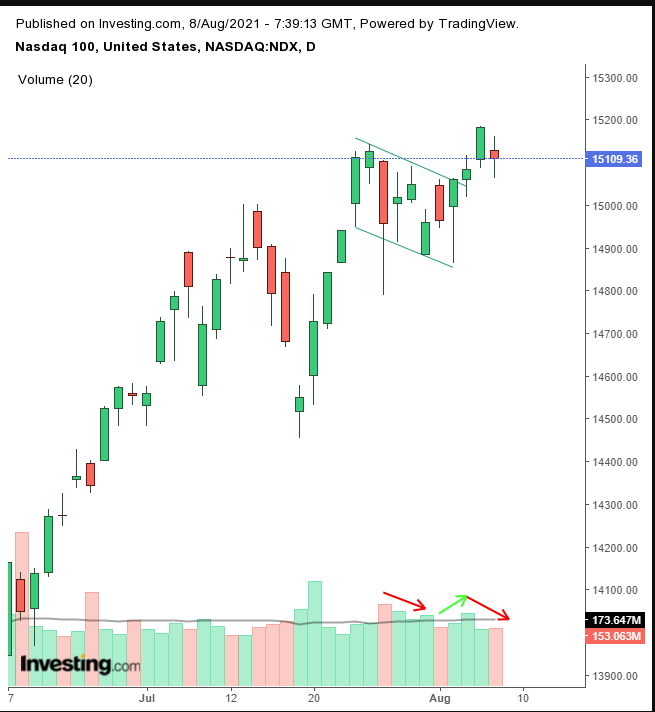- Jobs creation fuels record-setting rally, despite policy implications
- Reflation Trade back on track in almost all-time frames over a yearly period
US stocks extended gains on the final day of last week's trade, with the Dow Jones and S&P 500 closing at new record highs after Friday's nonfarm payrolls release provided an upside surprise. The Russell 2000 also closed higher though not at record levels, but the NASDAQ finished lower.
All signs point to the return, in force, of the Reflation Trade in the weeks ahead. Still, the better than anticipated jobs print could also create some negative repercussions—primarily it increases the odds of the Federal Reserve tightening monetary policy sooner rather than later.
More Records Ahead?
Payrolls climbed to 943,000, its biggest increase in almost a year, beating the 870,000 forecast, even after upward revisions in the two prior months. Unemployment dipped to 5.4%, the lowest level seen since the pandemic began. Wages and hours worked remained elevated.
Except for the NASDAQ indices, which slipped—the NASDAQ Composite by 0.4% and the NASDAQ 100 by 0.5%—all remaining key benchmarks finished in the green with the small cap Russell 2000, which lists domestic companies, outperforming, +0.5%. All of which signals the Reflation Trade is back in focus.
As well, when comparing sector performance within the S&P 500, value shares handily beat growth stocks. Financials led the rally, with a 2% acceleration, followed by Materials which rose1.5%; Energy came in third at +0.9%, with Industrials 0.5% in fourth place. Growth stocks—represented by Technology shares which thrived during the height of the pandemic—lagged, down 0.1%; Communication Services shares were flat.
In addition, over the past month and a half, as the Fed moved out its timeline for raising rates, the cyclical rotation has been gaining momentum. We’ve now reached the point where, on most timeframes in 2021, value has outperformed growth.
On a weekly basis, Financials, the sector that benefits most from interest rate increases, from which lenders derive profits, were up 3.67% for the week, nearly four times that of the performance of Technology shares, which grew just 0.95% during the same period, and nearly eight times that of Communication Services’ 0.51% gain. The latter sector is where such former high-flyers as Google (NASDAQ:GOOGL), Facebook (NASDAQ:FB) and Netflix (NASDAQ:NFLX)—pandemic darlings all—are listed.
Measured on a monthly timeframe, Financials jumped 4.1%, 25% more than Technology's 2.9% boost and nearly four times that of Communication Services.
It’s important to point out that Energy, another sector that’s sensitive to the economic cycle, fell 6.4% during the last month. However, that was driven by politics rather than a reflecting economy. OPEC+ members failed to reach an agreement on increasing pandemic-level oil production.
While it appears counterintuitive for prices to fall on lower supply, perhaps the idea of a market without leadership scared investors, especially after the instability of the worst global health crisis in a century. Of course, there were other factors, such as a stronger dollar year-to-date.
At this point, the only period of time in 2021 during which technology has dominated is on a three-month basis. The sector is up 12.3% over that timeframe, while Communication Services saw a 6.6% boost. Sectors on the other side of the Reflation Trade were mostly in red, though, Financials added 0.75%. Industrials were down 0.7%, Materials -3.3% and Energy, again mostly due to OPEC+ in-fighting, plummeted 6%.
Year-to-date the Reflation Trade also leads, though this time Energy is the frontrunner, +30.6%, followed by Financials, +28.4%; Industrials +16.9% and Materials +16.2%. The only sectors falling behind by this measure are Technology which 'only' advanced 19.1%; Communication Services, which benefited from lockdown restrictions, did better with a 22.7% rally.
Even on a 12-month scale, Financials come out on top, up 55.6%, which is more than 20% better than the Technology sector, which added 34.1% in value though Communications Services were still ahead of their peer sector, gaining 38% in profit.
Given that the Reflation Trade has clearly accelerated since the height of the pandemic, signaling that the economy is in full recovery mode and bolstered by Friday’s employment numbers, can we expect that a continued expansion will fuel ongoing record highs?
First—and this surprised us—this is the second time that we can remember when investors acted out of character in this market, increasing risk even as strong data would seem to push the Fed further into a corner, requiring the central bank to shrink an unprecedented level of bloat on their balance sheet and begin the raising interest rate cycle.
With only one exception that we can recall in recent memory, markets have sold off on indications of a faster expansion, increasing speculation for tightening policy. Yet despite Fed Governor Christopher Waller commenting last week that another pair of gains in the Nonfarm Payrolls print could be the catalyst for the central bank to begin tapering its massive bond purchases, risk-on dominated as trading came to a close on Friday.
Second, smart money seems to be getting edgy. Bank of America's chief equity strategist thinks that a market fully pricing-in any bullish news, including earnings, jobs growth and sentiment, calls for a 14% correction.
Warren Buffet’s recent actions suggest he too doesn’t think the current market is a buy. The Oracle of Omaha, aka the CEO of Berkshire Hathaway (NYSE:BRKb), didn't use most of the US $144B funds available to him. His share buybacks of Berkshire stock were “just” $6 billion, the lowest level for the revered investor since mid-2020.
Instead, he was a net seller of other stocks in his portfolio for a third straight quarter. And he increased his already elevated levels of cash from $128B to $144B. That doesn’t signal confidence in the current bull market.
What do we think? We're betting there's still some life in this rally, especially for the Dow and NASDAQ indices.

The 30-component, mega-cap Dow completed a falling flag, bullish after the 4% jump within the preceding 5 sessions. While the breakout volume didn’t show wide participation, it was down with a breakaway gap, which could set a market chain reaction in place, leading to the next leg up.

The tech-heavy NASDAQ 100 also completed a falling flag. It's presumed to be fueled by bulls after the market jumped 4.75% in a preceding five-day straight rally. While this pattern wasn’t boosted by a breakaway gap, it did display the level of volume expected of a potent bullish flag, drying up during its development, rising with the upside breakout, then evaporating upon a pullback.
The Week Ahead
All times listed are EDT
Sunday
21:30: China – CPI: anticipated to slip to 0.8% YoY from 1.1% previously.
Monday
10:00: US – JOLTs Job Openings: expected to rise 9.270M from 9.209M.
Tuesday
5:00: Germany – ZEW Economic Sentiment: seen to drop to 57.0 from 63.3.
Wednesday
8:30: US – Core CPI: to drop by nearly half, to 0.4% from 0.9%.
10:00: US – Crude Oil Inventories: forecast to plunge to -3.102M from a downwardly revised 3.626M.
Thursday
2:00: UK – GDP: predicted to surge to 4.8% from -1.6% QoQ and to a whopping 22.1% from -6.1% YoY.
2:00: UK – Manufacturing Production: likely to rise to 0.4% from -0.1%.
8:30: US – Initial Jobless Claims: anticipated to edge down to 373K from 385K.
8:30: US – PPI: to retreat to 0.6% from 1.0%.
21:30: Australia – Employment Change: seen to rise to 30.0K from 29.1K.
Friday
10:00: US – Michigan Consumer Sentiment: expected to remain flat at 81.2.
